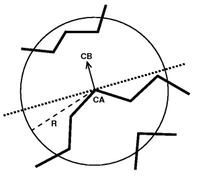Half sphere exposure

Half Sphere Exposure (HSE) is a protein solvent exposure measure that was first introduced by Hamelryck (2005).[1] Like all solvent exposure measures it measures how buried amino acid residues are in a protein. It is found by counting the number of amino acid neighbors within two half spheres of chosen radius around the amino acid. The calculation of HSE is found by dividing a contact number (CN) sphere in two halves by the plane perpendicular to the Cβ-Cα vector. This simple division of the CN sphere results in two strikingly different measures, HSE-up and HSE-down. HSE-up is defined as the number of Cα atoms in the upper half (containing the pseudo-Cβ atom) and analogously HSE-down is defined as the number of Cα atoms in the opposite sphere.
If only Cα atoms are available (as is the case for many simplified representations of protein structure), a related measure, called HSEα, can be used. HSEα uses a pseudo-Cβ instead of the real Cβ atom for its calculation. The position of this pseudo-Cβ atom (pCβ) is derived from the positions of preceding Cα−1 and the following Cα+1. The Cα-pCβ vector is calculated by adding the Cα−1-Cα0 and Cα+1-Cα0 vectors.
HSE is used in predicting discontinuous B-cell epitopes.[2] Recently Song et al. have developed an online webserver termed HSEpred to predict half-sphere exposure from protein primary sequences.[3] HSEpred server can achieve the correlation coefficients of 0.72 and 0.68 between the predicted and observed HSE-up and HSE-down measures, respectively, when evaluated on a well-prepared non-homologous protein structure dataset. Moreover, residue contact number (CN) can also be accurately predicted by HSEpred webserver using the summation of the predicted HSE-up and HSE-down values, which has further enlarged the application of this new solvent exposure measure.
References
- ↑ Hamelryck, T. (2005), "An amino acid has two sides: A new 2D measure provides a different view of solvent exposure", Proteins : Structure, Function, and Bioinformatics 59 (1): 38–48, doi:10.1002/prot.20379, PMID 15688434.
- ↑ Sweredoski, Michael J.; Baldi, Pierre (2008), "PEPITO: Improved discontinuous B-cell epitope prediction using multiple distance thresholds and Half Sphere Exposure", Bioinformatics 24 (12): 1459–1460, doi:10.1093/bioinformatics/btn199, PMID 18443018.
- ↑ Song, J.; Tan, H.; Takemoto, K.; Akutsu, T. (2008), "HSEpred: predict half-sphere exposure from protein sequences", Bioinformatics 24 (13): 1489–1497, doi:10.1093/bioinformatics/btn222, PMID 18467349.